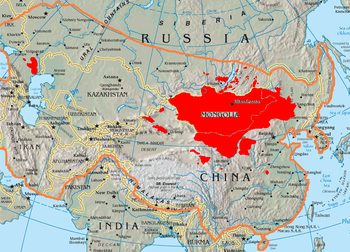- Greater Mongolia
-
Greater Mongolia as a region, is the contiguous territories primarily inhabited by ethnic Mongols. It approximately includes the modern state of Mongolia, the Inner Mongolia Autonomous Region in the People's Republic of China (PRC), and the Buryat Republic as well as a few smaller territories in Russia.
The people in this area share the common traditional culture to varying degrees, and they speak one of several Mongolic languages. With the exception of the state of Mongolia, Mongols now only form a minority in most of these areas.
History
The area of Greater Mongolia, combining both Inner and Outer Mongolia, has been inhabited by Mongolic peoples descended from the Donghu people, including the Xianbei, Wuhuan, Rouran, Tuoba, Murong, Shiwei, Kumo Xi and Khitan. The Donghu, the first relatively certain Mongolic people, are first mentioned by Sima Qian as already existing in Inner Mongolia north of the state of Yan in 699-632 BC. Except for periods of Turkic rule during the Gokturk Empire (555-745), Uyghur Empire (745-840) and Kyrgyz domination (840-907), the lands of Greater Mongolia were generally under the rule of Mongolic peoples, including the Donghu (632 BC-208 BC), Xianbei (208 BC-234 AD), Rouran (330-555) and Khitan (388-1125). During the periods of Turkic rule, Mongolic Xianbei peoples continued to live in the land as subjects. Ever since the establishment of the Mongolic Liao dynasty in 907, the area of Greater Mongolia, in particular the Mongolian Plateau, began to be inhabited largely by speakers of Mongolic languages, as the Uyghurs and Kyrgyz permanently left the area.
The Mongols, in other words the Menggu sub-tribe of the Shiwei Xianbei, resisted attempts by the Tungusic Jin dynasty from Manchuria to increase its influence in the greater Mongolia region. This was during the Khamag Mongol period in the 12th century. During the Mongol Empire (1206-1368) the area of Greater Mongolia grew ever more important[peacock term] as the original land of the Mongol Khans and continued to retain its Mongol character. After the fall of the Empire, the Mongols continued to hold the area as the Northern Yuan Dynasty until the last Khan, Ligdan Khan, died in 1634. During this time, in the 15th century, the Ming Dynasty controlled parts of Inner Mongolia and sent expeditions into Outer Mongolia. Because of the Mongol threat, the Ming occasionally strengthened and retreated behind the Great Wall. In 1691 the princes of Khalkha submitted to the Qing Emperor at Dolon Nur due to their military conflict with the Oirat. The Manchu Qing Dynasty also sponsored Mongolian literature and Mongolian Buddhism, while allowing Greater Mongolia to be ruled by Genghisid khaganates such as Tushiyetu Khaganate (1577-1937), Sechen Khaganate and Jasagtu Khaganate. For example, the Mongol-Manchu bilingual golden seal of the hereditary Tushiyetu Khan has an inscription in Mongolian script which reads "Qalqa-yin Wchirai Batu Tushiyetu Qagan-u Tamga" (Seal of the Thunderbolt Firm Supported Khagan of the Khalkha). Nationalism among Mongols became especially strong in the late 19th century, reaching a height during the unexpected Qing sinification policy (prompted by fears of Russian expansion)[citation needed] of 1900. In the end, the Manchus were thoroughly sinified by the 20th century,[citation needed] while the Mongols were not only culturally "untouched", but fervently anti-Chinese as well.
After Outer Mongolia's Declaration of independence in late 1911, the Bogd Khan government initially sought to unify both Inner and Outer Mongolia. Troops were sent into Inner Mongolia, but had to be called back after Russia became worried that these moves might provoke a conflict with the Empire of Japan. In 1911 the Tushiyetu Khan Dashnyam, as the Khan of the Senior Genghisid Khanate ruling central Outer Mongolia, sought the title of supreme Khan of Mongolia and nearly succeeded. In 1919, the Japanese set up a pan-Mongolian movement under Grigory Semyonov in northeastern Inner Mongolia, but the Bogd Khan government refused to join. Roman Ungern von Sternberg also made some references to pan-Mongolism.
After Ungern von Sternberg's defeat by the Red Army on the Russian territory, the new socialist regime of Mongolia further considered the idea. But under pressure of the Komintern, which regarded alienating China for the sake of less than two million Mongols as a non-issue,[citation needed] these policies had to be dropped in the mid-1920s. The 23rd and last Tushiyetu Khagan Dorjsurenkhoroljav (1908-1937) gave up his royal status to become a lama with the new name of Damdindorj before being executed in the Stalinist purges of 1937. The book called "Short History of Mongolia" (Ulaanbaatar, 1934) written by Prime Minister Anandyn Amar is an early pan-Mongolist manifesto.
Another revival of pan-Mongol sentiments came at the end of World War II, when Outer Mongolian troops took part in the Soviet Operations against Mengjiang (see Soviet invasion of Manchuria). However, Outer Mongolian troops were quickly withdrawn after the end of hostilities.
Following Mongolia's democratic reforms in 1991, several non-governmental organizations reintroduced efforts to advocate pan-Mongolianism. In Mongolia those are the "Movement for Unity of the Mongol Nation", in Buryatia the "Movement for National Unity Negeden" and the "Buryat-Mongol People's Party". However, none of those organizations has gained any significant political influence.[1]
See also
References
- ^ David Johnson, 9. Russia-Mongolia: Latent Territorial Issues, Center for Defense Information, 2003
Irredentist movements in the world Africa Asia The Balkans The Caucasus Rest of Europe Middle East South America Argentina
Categories:- Irredentism
- Geography of Central Asia
- Divided regions
- Geography of Mongolia
- Pan movements
Wikimedia Foundation. 2010.

